Abstract
Adaptive network models arise when describing processes in a wide range of fields and are characterized by some specific effects. One of them is mixed dynamics, which is the third type of chaos in addition to the conservative and dissipative types. In this work, we consider a more complex type of connections between network elements—simplex, or higher-order adaptive interactions. Using numerical simulation methods, we analyze various characteristics of mixed dynamics and compare them with the case of pairwise couplings. We found that mixed dynamics in the case of simplex interactions is characterized by a very high similarity of a chaotic attractor to a chaotic repeller, as well as a stronger closeness of the sum of the Lyapunov exponents of the attractor and repeller to zero. This means that in the case of three elements, the conservative properties of the system are more pronounced than in the case of two.
MSC:
37D45
1. Introduction
Nowadays, networks of many coupled oscillating elements are of great interest. The basic model for describing oscillating elements is the Kuramoto model [1,2]. The elements of the network can be connected in various ways. The most reliable, in our opinion, is the model of adaptive couplings, when the values of the coupling coefficients evolve together with the states of the elements [3,4]. An example is the neural networks of the brain, where the electrochemical activity of individual cells changes simultaneously with the activity of axonal connections between them [5]. Using models of adaptive couplings, it is also possible to describe chemical [6], physiological [7], social [8] systems, power grids [9] and many other systems.
Usually the network elements are connected in pairs by links. However, recent studies show that in real physical systems, there are also group-level interactions. Thus, some systems can be better described in terms of higher-order interactions, when the units form geometric objects of different dimensions that reflect the underlying geometry of complex systems [10]. Such properties are observed, for example, in functional [11,12,13] and structural [14] brain networks, protein interaction networks [15], semantic networks [16] and co-Authorship graphs in science [17].
In this paper, we study the dynamics of a small ensemble of higher-order adaptively coupled Kuramoto oscillators, consisting of three elements. In particular, we investigate the question of the presence of mixed dynamics in this system. Mixed dynamics is a new, third type of chaos, which is characterized by the coexistence of conservative and dissipative behavior of the system. The term “mixed dynamics” was first introduced in [18], but the phenomenon of inseparability of attractors, repellers, and conservative elements of dynamics in phase space of some dynamical systems was firstly shown in [19]. The mathematical justification for the existence of the third type of chaos is given in [20]. The image of mixed dynamics is the limiting invariant set consisting of saddle trajectories along which the chaotic attractor and the chaotic repeller of the dissipative system intersect, but do not coincide—the reversible core. This phenomenon is observed mainly in a narrow class of time-reversible systems, such as oscillator lattices [21], a balanced rubber ball rolling on a plane [22], a Celtic stone [23], the Suslov problem [24], the Chaplygin sleigh [25], the Pikovsky–Topaj system of coupled rotators [26], or a particle propelled in a regular flow [27]. Moreover, these systems are weakly dissipative, i.e., they are obtained by a weak perturbation of conservative systems. It was shown that mixed dynamics can also be present in strongly dissipative systems [28]. In this case, the chaotic attractor and the chaotic repeller intersect at a small number of points. The mathematical substantiation of the intersections of the attractor and the repeller is given in the above papers and is generalized in the works [29,30,31].
Relatively recently, it was shown that the third type of chaos can also exist in irreversible systems, such as a system of two adaptively coupled Kuramoto oscillators [32,33,34,35,36]. In these works, it was shown that in the system of two adaptively coupled Kuramoto oscillators, a chaotic attractor and a chaotic repeller simultaneously exist, and the invariant manifolds of their saddle trajectories intersect [32]. Some properties of the reversible core were studied, and the coexistence of conservative and dissipative elements of dynamics was shown [33]. The influence of an external force [34] and nonisochronism [35] on mixed dynamics was investigated, and a chaotic oscillation generator based on the concept of mixed dynamics was implemented on the field programmable gate array [36].
In this paper, we are the first to consider a system of adaptively coupled phase oscillators with higher-order interactions, which exhibits mixed dynamics and has the following distinctive properties:
- It is irreversible, i.e., it does not have symmetry with respect to the change of the sign of time and the simultaneous reversal or shift of variables.
- It is strongly dissipative, i.e., it is impossible to eliminate dissipation in it by removing some parameter, and it is impossible to reduce it to a conservative system.
- It is high-dimensional (six-dimensional). Namely, it has the largest dimension compared to other previously discovered systems with mixed dynamics. This fact complicates the search for the intersection points of a chaotic attractor and a chaotic repeller.
2. Materials and Methods
We consider a system of three higher-order adaptively coupled Kuramoto oscillators, which can be written as follows:
where are the phases of the oscillators and are the coupling weights. In the three-element case, and , therefore we designate and consider six-dimensional phase space. The parameter can be regarded as the phase lag in the coupling, the parameter controls the features of the adaptation function, the parameter defines the scale separation between the fast dynamics of the phases and the slow dynamics of adaptation, are the natural frequencies of the oscillators, and is the uniform coupling strength among the interacting elements. Further, in the paper, we vary the parameter , since it most strongly affects the dynamics of the system, changing the adaptation rule. For example, for , the adaptation rule is STDP-like; for , it is anti-Hebbian; and for , it is Hebbian.
System (1) is of great interest from the point of view of applications, since it can describe ensembles of self-oscillating elements, in particular, neural ensembles in the brain. In [37,38], a network of such coupled phase oscillators with pairwise couplings was considered; however, couplings evolved according to a slightly different rule. It was shown that there were three modes in the system: a two-cluster state, a coherent state, and a chaotic state. In [39], for a network with pairwise couplings, it was shown that either alternation of two oscillation modes in the order of spikes between nodes or switching between metastable states when the phases show burst-like behavior can be observed in the presence of noise in the system. System (1) was studied in [40] for homogeneous oscillators and pairwise couplings. It was shown that the system can demonstrate both regular and chaotic dynamics. The authors demonstrated the way the chaotic attractor and the chaotic repeller of the system were formed. The case of the network with higher-order interactions and Hebbian plasticity rule was considered in [41]. It was shown that the insertion of such interactions leads to an abrupt jump in the order parameter with variation in the coupling strength parameter.
We carried out numerical simulations of system (1) in forward and reverse time and found that, under certain parameter values, there is a chaotic attractor in phase space of the system in forward time, and there is a chaotic repeller in reverse time. We argue that, in this case, there is mixed dynamics in system (1). Below, we describe our arguments in favor of this statement.
For numerical simulation of system (1), we use the fourth-order Runge–Kutta method with a constant step of 0.1, skipping the transition process time of . We take the following initial conditions: , . With appropriate parameter values, these initial conditions ensure that the trajectory reaches the chaotic attractor in forward time and the chaotic repeller in reverse time.
For investigating the various characteristics of mixed dynamics that we have also previously explored in the case of two elements [32,33,34,35,36], we used the following methods. We calculated the distance between the chaotic attractor and the chaotic repeller, according to the formula:
where and () are the coordinates of the attractor’s points, and are the coordinates of the repeller’s points, i and j are the indices of the attractor’s and repeller’s points, respectively.
Another characteristic of mixed dynamics is the fractal dimension of the chaotic attractor, of the chaotic repeller, and of the reversible core. We calculate the fractal dimension using the box-counting method, which is well described in [42]. For calculating the fractal dimension of the reversible core, we consider that if the distance between the attractor and the repeller is sufficiently small, namely, less than 0.01, then the points at which this condition is satisfied belong to the reversible core.
Also, we calculate the Kantorovich–Rubinstein–Wasserstein distance () between the chaotic attractor and the chaotic repeller, which reflects the degree of similarity of the attractor and repeller as sets [43]. We calculate the using a free available program code [44].
And the last characteristic is the sum of the Lyapunov exponents of the chaotic attractor. We calculated the Lyapunov exponents using the Benettin algorithm described in [45].
3. Results
3.1. Phase Space
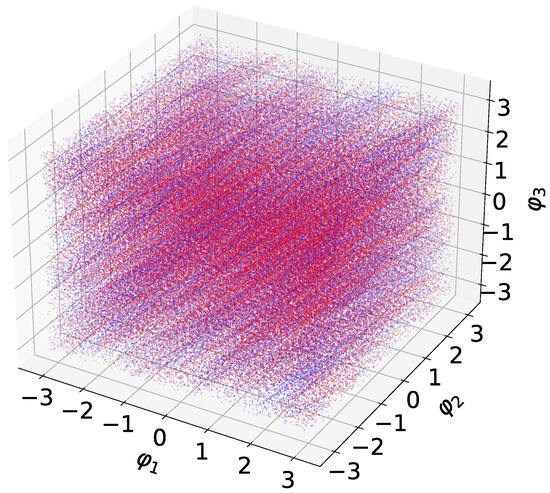
Figure 1.
The projections of the chaotic attractor (blue) and of the chaotic repeller (red) in the space .
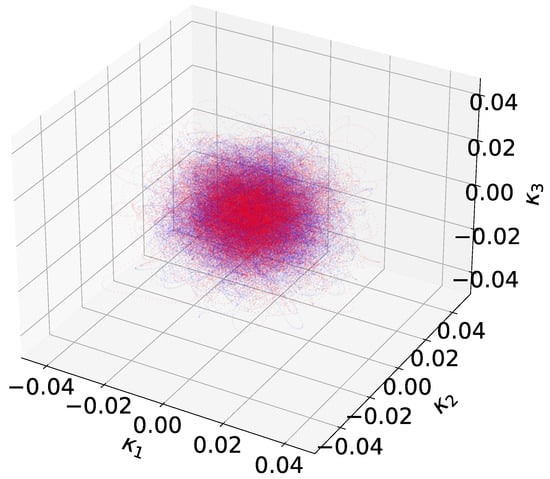
Figure 2.
The projections of the chaotic attractor (blue) and of the chaotic repeller (red) in the space .
Our numerical simulation shows that, for parameter values , a chaotic attractor and a chaotic repeller exist in system (1). We should note that the parameters have exactly the same values as in the case of mixed dynamics in the system of two adaptively coupled phase oscillators, and the detuning of the natural frequencies between adjacent oscillators also is , which is equal to the detuning of the natural frequencies in the case of mixed dynamics in the system of two adaptively coupled phase oscillators. Thus, the phenomenon of mixed dynamics is to some extent robust, in the sense that mixed dynamics is preserved when the number of interacting oscillators increases from two to three. Next in the paper, we fix the parameter values (except for the Figures 3–9, where we change ).
The projections of the chaotic attractor and of the chaotic repeller in the spaces and are shown in the Figure 1 and Figure 2, respectively. It is worth noting that, in contrast to the case of pairwise interactions, with higher-order simplex interactions, the chaotic attractor and the chaotic repeller look almost the same, while in the case of two elements, the attractor and the repeller look different in shape. This result, in our opinion, indicates that the dissipative system (1) behaves more as a conservative one (when the “attractor” and the “repeller” coincide, filling the entire phase space) than in the case of two elements. Such a strong similarity also resembles mixed dynamics in reversible weakly dissipative systems, but system (1) is strongly dissipative and irreversible.
The phenomenon is robust since it exists in a range of parameters. Our calculations show that the chaotic attractor and the chaotic repeller exist simultaneously in the interval . Figure 3 and Figure 4 show the spectra of the Lyapunov exponents for the chaotic attractor and for the chaotic repeller in this interval. It follows from these plots that the Lyapunov exponents of the attractor and of the repeller are very similar in their values if we take into account that the Lyapunov exponents of the repeller have opposite values in comparison with the Lyapunov exponents of the attractor, i.e., for the repeller, negative Lyapunov exponents mean the presence of chaos. Both the chaotic attractor and the chaotic repeller have two positive, two zero, and two negative Lyapunov exponents. The presence of two zero Lyapunov exponents means that, most likely, the structure of the chaotic attractor and the chaotic repeller contains some two-dimensional invariant manifold [46,47]. Outside this interval, the chaotic repeller disappears, and the trajectories in reverse time go to infinity. When the parameter varies outside this interval, the chaotic attractor firstly turns into a chaotic attractor with one positive, two zero, and three negative Lyapunov exponents, then with one positive, one zero, and four negative exponents, and then it turns into a stable limit cycle with one zero and five negative Lyapunov exponents. Thus, the structure that exists in the interval and consists of chaotic sets with two positive, two zero, and two negative Lyapunov exponents in forward and reverse time, which can be also considered as the reversible core of system (1), collapses at the boundaries of this interval, and mixed dynamics disappears. As in the case of two elements, we again have a bifurcation resembling a saddle-node bifurcation, which in our previous papers we called the “attractor-repeller bifurcation”.
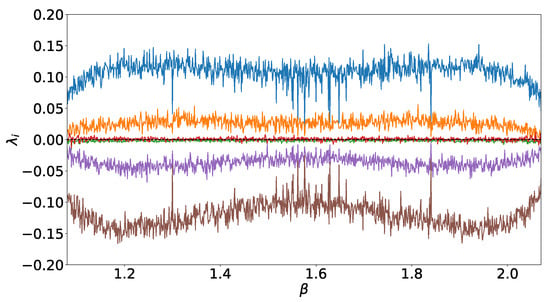
Figure 3.
The Lyapunov exponents of the chaotic attractor in the interval .
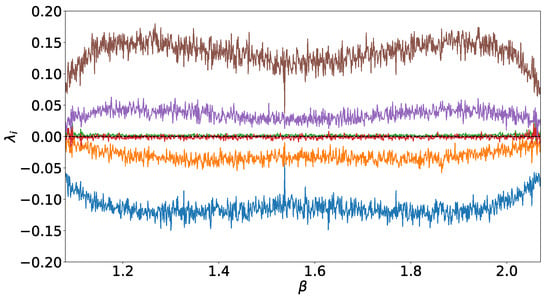
Figure 4.
The Lyapunov exponents of the chaotic repeller in the interval .
3.2. The Kantorovich–Rubinstein–Wasserstein Distance
Since the chaotic attractor and the chaotic repeller are very alike, it seems logical to calculate the Kantorovich–Rubinstein–Wasserstein () distance between them, which is a measure of similarity between two probability measures. It led to the value of . This is less than for the nonautonomous [34] and nonisochronous [35] systems of two adaptively coupled phase oscillators with equal natural frequencies, but it is slightly larger than in the case of nonisochronism and detuning of the natural frequencies of the oscillators.
3.3. The Euclidian Distance
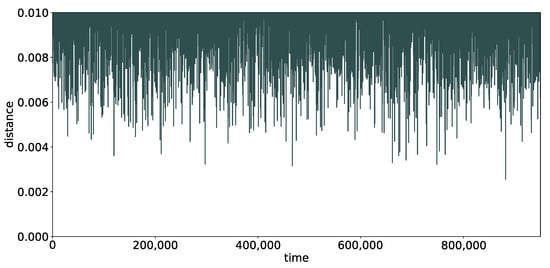
Figure 5.
The Euclidian distance between the chaotic attractor and the chaotic repeller.
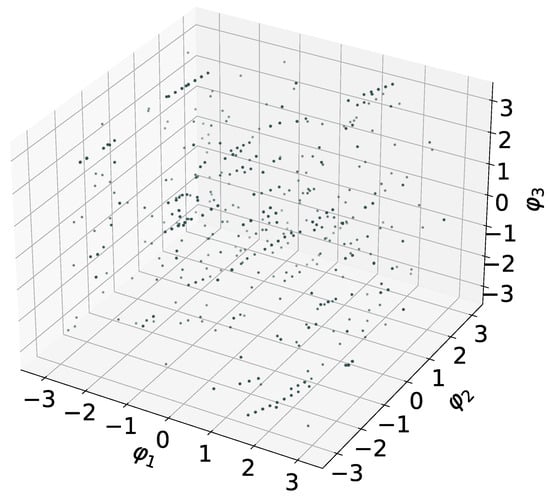
Figure 6.
The projections of the reversible core in the space .
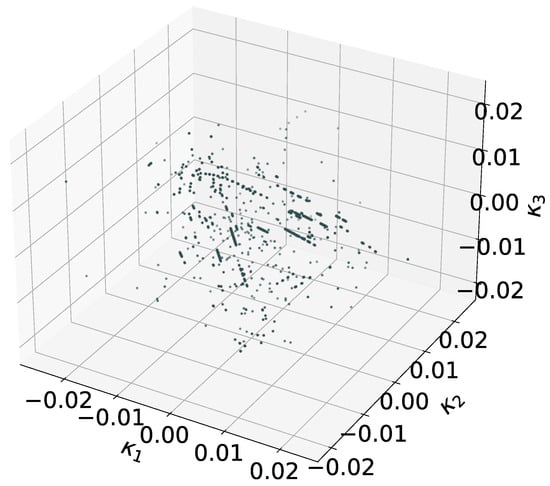
Figure 7.
The projections of the reversible core in the space .
Since system (1) has a six-dimensional phase space, we cannot, as we did in our previous works, explicitly establish the intersection of the invariant manifolds of the saddle trajectories of the chaotic attractor and the chaotic repeller. We can only extend to the case of three elements our statement that for all close saddle trajectories of the attractor and of the repeller, their invariant manifolds intersect.
The result of calculating the Euclidean distance between the chaotic attractor and the chaotic repeller is shown in Figure 5. It is quite small, but on average it is larger than the distance in the case of two elements. In particular, for this long trajectory, it never even reaches the value of , which we took as a threshold for determining the presence of mixed dynamics in our previous works. This may be due to the fact that system (1) has a higher dimension; therefore, most likely, if we take an even longer trajectory, the distance will take smaller values. However, this will lead to a very large increase in calculation time. Therefore, we take the threshold for in this work; i.e., the points at which the distance between the attractor and the repeller is less than this value, we refer to as the reversible core. In Figure 6 and Figure 7, one can see the projections of the reversible core, i.e., the set of points at which the distance between the attractor and the repeller is less than 0.01.
3.4. The Fractal Dimensions
We calculate the fractal dimensions of the chaotic attractor, of the chaotic repeller, and of the reversible core. The results are as follows: for the chaotic attractor; for the chaotic repeller; and for the reversible core. Thus, firstly, the fractal dimensions of the attractor and repeller are equal, which can be explained by the fact that they are very alike in system (1). Secondly, the fractal dimensions of the chaotic attractor, of the chaotic repeller, and of the reversible core in system (1) are almost the same as in the case of two oscillators when rounding to tenths (between 2 and 3 for the attractor and for the repeller and between 1 and 2 for the reversible core) [33].
3.5. The Sum of the Lyapunov Exponents
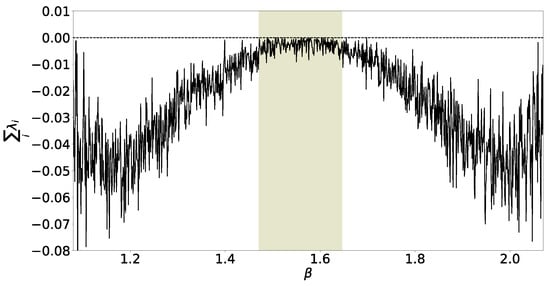
Figure 8.
The sum of the Lyapunov exponents of the chaotic attractor in the interval . The color background shows the interval where .
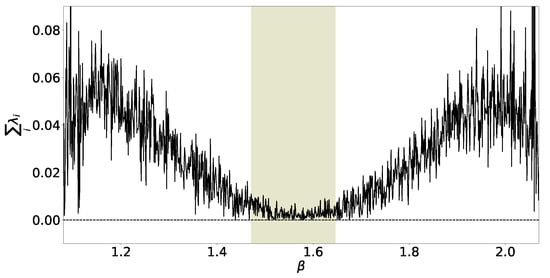
Figure 9.
The sum of the Lyapunov exponents of the chaotic repeller in the interval . The color background shows the interval where .
In Figure 8 and Figure 9, one can see the sum of the Lyapunov exponents of the chaotic attractor and of the chaotic repeller, respectively. The sum of the Lyapunov exponents in system (1) is at least an order of magnitude smaller than in the case of two elements. This means that the conservative properties of system (1) are more pronounced in the case of three elements. In the interval , which is shown in color in Figure 8 and Figure 9, it is less than 0.01, and, at some points, it reaches the values of the order . Thus, in this interval, the conservative properties of the dissipative system (1) are most pronounced. Note that the value , for which we calculate all the characteristics both in the case of two elements and in the case of three, is included in this interval. It is also worth noting that almost the middle of this interval is the value . This means that the properties of mixed dynamics are most pronounced for the anti-Hebbian adaptation rule.
4. Discussion
The phenomenon of mixed dynamics is observed in a system of three adaptively coupled Kuramoto oscillators with higher-order simplex interactions. We found that mixed dynamics in this case differ from the case of two elements considered in our previous works. In particular, in the case of three elements, the chaotic attractor and the chaotic repeller are very alike. This can be seen both visually in projections and by the fact that their fractal dimensions and Lyapunov exponents almost coincide. Also, in the considered case, the sum of the Lyapunov exponents in forward and reverse time is closer to zero by an order of magnitude than in the case of two elements. These facts allow us to conclude that the conservative properties of the system of three adaptively coupled Kuramoto oscillators with simplex interactions are more pronounced than in the case of two oscillators. These properties are especially pronounced for the anti-Hebbian adaptation rule. At the same time, the Kantorovich–Rubinstein–Wasserstein distance and the fractal dimensions do not differ significantly in the case of two and three oscillators. It is also worth noting that in the case of three elements, we again observe the simultaneous appearance and disappearance of the chaotic attractor and the chaotic repeller with two zero Lyapunov exponents, which resembles a saddle-node bifurcation and can be called a more complex type of attractor–repeller bifurcation.
Finally, we present a comparative Table 1 that reflects the advantages of the system we considered in relation to some other systems with mixed dynamics. The data in the Table confirms that, in addition to the fact that system (1) is irreversible, strongly dissipative and higher-dimensional than other systems with mixed dynamics, it also has more pronounced features of a conservative system compared to other irreversible systems with mixed dynamics, but some of the properties are almost the same.

Table 1.
Characteristics of some systems with mixed dynamics.
Author Contributions
Conceptualization, V.I.N.; methodology, A.A.E. and V.I.N.; software, A.A.E.; validation, A.A.E. and V.I.N.; formal analysis, A.A.E. and V.I.N.; investigation, A.A.E. and V.I.N.; resources, A.A.E. and V.I.N.; data curation, A.A.E. and V.I.N.; writing—original draft preparation, A.A.E.; writing—review and editing, A.A.E. and V.I.N.; visualization, A.A.E.; supervision, V.I.N.; project administration, V.I.N.; funding acquisition, V.I.N. All authors have read and agreed to the published version of the manuscript.
Funding
This research was funded by the Russian Science Foundation grant number 19-12-00338.
Data Availability Statement
No new data were created or analyzed in this study. Data sharing is not applicable to this article.
Conflicts of Interest
The authors declare no conflict of interest. The funders had no role in the design of the study; in the collection, analyses, or interpretation of data; in the writing of the manuscript; or in the decision to publish the results.
References
- Kuramoto, Y. Self-entrainment of a population of coupled non-linear oscillators. In International Symposium on Mathematical Problems in Theoretical Physics, Lecture Notes in Physics; Araki, H., Ed.; Springer: Berlin/Heidelberg, Germany, 1975; pp. 420–422. [Google Scholar]
- Kuramoto, Y. Chemical Oscillations, Waves and Turbulence; Springer: Berlin/Heidelberg, Germany, 1984. [Google Scholar]
- Maslennikov, O.V.; Nekorkin, V.I. Adaptive dynamical networks. Uspekhi Fiz. Nauk (UFN) 2017, 60, 694–704. [Google Scholar] [CrossRef]
- Berner, R.; Gross, T.; Kuehn, C.; Kurths, J.; Yanchuk, S. Adaptive dynamical networks. Phys. Rep. 2023, 1031, 1–59. [Google Scholar] [CrossRef]
- Lücken, L.; Popovych, O.V.; Tass, P.A.; Yanchuk, S. Noise-enhanced coupling between two oscillators with long-term plasticity. Phys. Rev. E 2016, 93, 032210. [Google Scholar] [CrossRef]
- Kuehn, C. Multiscale dynamics of an adaptive catalytic network. Math. Model. Nat. Phenom. 2019, 14, 402. [Google Scholar] [CrossRef]
- Sawicki, J.; Berner, R.; Löser, T.; Schöll, E. Modeling Tumor Disease and Sepsis by Networks of Adaptively Coupled Phase Oscillators. Front. Netw. Physiol. 2022, 1, 730385. [Google Scholar] [CrossRef]
- Horstmeyer, L.; Kuehn, C. Adaptive voter model on simplicial complexes. Phys. Rev. E 2020, 101, 022305. [Google Scholar] [CrossRef]
- Berner, R.; Yanchuk, S.; Schöll, E. What adaptive neuronal networks teach us about power grids. Phys. Rev. E 2021, 103, 042315. [Google Scholar] [CrossRef]
- Boccaletti, S.; Lellis, P.D.; del Genio, C.; Alfaro-Bittner, K.; Criado, R.; Jalan, S.; Romance, M. The structure and dynamics of networks with higher order interactions. Phys. Rep. 2023, 1018, 1–64. [Google Scholar] [CrossRef]
- Petri, G.; Expert, P.; Turkheimer, F.; Carhart-Harris, R.; Nutt, D.; Hellyer, P.; Vaccarino, F. Homological Scaffolds of brain functional networks. J. R. Soc. Interface 2014, 11, 20140873. [Google Scholar] [CrossRef]
- Lord, L.D.; Expert, P.; Fernandes, H.; Petri, G.; Hartevelt, T.V.; Vaccarino, F.; Deco, G.; Turkheimer, F.; Kringelbach, M. Insights into brain architectures from the homological Scaffolds of functional connectivity networks. Front. Syst. Neurosci. 2016, 10, 85. [Google Scholar] [CrossRef]
- Lee, H.; Kang, H.; Chung, M.; Kim, B.N.; Lee, D. Persistent brain network homology from the perspective of dendrogram. IEEE Trans. Med. Imaging 2012, 31, 2267–2277. [Google Scholar] [CrossRef]
- Sizemore, A.; Giusti, C.; Kahn, A.; Vettel, J.; Betzel, R.; Bassett, D. Cliques and cavities in the human connectome. J. Comp. Neurosci. 2018, 44, 115–145. [Google Scholar] [CrossRef]
- Estrada, E.; Ross, G. Centralities in simplicial complexes. Applications to protein interaction networks. J. Theoret. Biol. 2018, 438, 46–60. [Google Scholar] [CrossRef]
- Sizemore, A.; Karuza, E.; Giusti, C.; Bassett, D. Knowledge gaps in the early growth of semantic networks. arXiv 2017. [Google Scholar] [CrossRef]
- Patania, A.; Petri, G.; Vaccarino, F. The shape of collaborations. EPJ Data Sci. 2017, 6, 18. [Google Scholar] [CrossRef]
- Delshams, A.; Gonchenko, S.V.; Gonchenko, V.S.; Lázaro, J.T.; Stenkin, O. Abundance of attracting, repelling and elliptic periodic orbits in two-dimensional reversible maps. Nonlinearity 2012, 26, 1–33. [Google Scholar] [CrossRef]
- Gonchenko, S.V.; Turaev, D.V.; Shil’nikov, L.P. On Newhouse domains of two-dimensional diffeomorphisms that are close to a diffeomorphism with a structurally unstable heteroclinic contour. Proc. Steklov Inst. Math. Russ. Acad. Sci. 1997, 216, 76–125. [Google Scholar]
- Gonchenko, S.V.; Turaev, D.V. On three types of dynamics and the notion of attractor. Proc. Steklov Inst. Math. Russ. Acad. Sci. 2017, 297, 116–137. [Google Scholar] [CrossRef]
- Topaj, D.; Pikovsky, A. Reversibility vs. synchronization in oscillator lattices. Phys. D Nonlinear Phenom. 2002, 170, 118–130. [Google Scholar] [CrossRef]
- Kazakov, A.O. Strange attractors and mixed dynamics in the problem of an unbalanced rubber ball rolling on a plane. Regul. Chaotic Dyn. 2013, 18, 508–520. [Google Scholar] [CrossRef]
- Gonchenko, A.S.; Gonchenko, S.V.; Kazakov, A.O. Richness of chaotic dynamics in nonholonomic models of a Celtic stone. Regul. Chaotic Dyn. 2013, 18, 521–538. [Google Scholar] [CrossRef]
- Bizyaev, I.A.; Borisov, A.V.; Kazakov, A.O. Dynamics of the Suslov Problem in a Gravitational Field: Reversal and Strange Attractors. Regul. Chaotic Dyn. 2015, 20, 605–626. [Google Scholar] [CrossRef]
- Kuznetsov, S.P. Regular and chaotic motions of the Chaplygin sleigh with periodically switched location of nonholonomic constraint. Europhys. Lett. 2017, 118, 10007. [Google Scholar] [CrossRef]
- Gonchenko, A.S.; Gonchenko, S.V.; Kazakov, A.O.; Turaev, D.V. On the phenomenon of mixed dynamics in Pikovsky-Topaj system of coupled rotators. Phys. D Nonlinear Phenom. 2017, 350, 45–57. [Google Scholar] [CrossRef]
- Ariel, G.; Schiff, J. Conservative, dissipative and super-diffusive behavior of a particle propelled in a regular flow. Phys. D Nonlinear Phenom. 2020, 411, 132584. [Google Scholar] [CrossRef]
- Kazakov, A.O. Merger of a Hénon-like attractor with a Hénon-like repeller in a model of vortex dynamics. Chaos 2020, 30, 011105. [Google Scholar] [CrossRef]
- Kazakov, A.O. On the appearance of mixed dynamics as a result of collision of strange attractors and repellers in reversible systems. Radiophys. Quantum Electron. 2019, 61, 650–658. [Google Scholar] [CrossRef]
- Gonchenko, S.V.; Gonchenko, M.S.; Sinitsky, I.O. On the mixed dynamics of two-dimensional reversible diffeomorphisms with symmetric heteroclinic contours (Russian). Izv. Ross. Akad. Nauk. Seriya Mat. 2020, 84, 23–51. [Google Scholar] [CrossRef]
- Turaev, D. A criterion for mixed dynamics in two-dimensional reversible maps. Chaos 2021, 31, 043133. [Google Scholar] [CrossRef]
- Emelianova, A.A.; Nekorkin, V.I. On the intersection of a chaotic attractor and a chaotic repeller in the system of two adaptively coupled phase oscillators. Chaos 2019, 29, 111102. [Google Scholar] [CrossRef]
- Emelianova, A.A.; Nekorkin, V.I. The third type of chaos in a system of two adaptively coupled phase oscillators. Chaos 2020, 30, 051105. [Google Scholar] [CrossRef] [PubMed]
- Emelianova, A.A.; Nekorkin, V.I. Emergence and synchronization of a reversible core in a system of forced adaptively coupled Kuramoto oscillators. Chaos 2021, 31, 033102. [Google Scholar] [CrossRef] [PubMed]
- Emelianova, A.A.; Nekorkin, V.I. The influence of nonisochronism on mixed dynamics in a system of two adaptively coupled rotators. Chaos Solitons Fractals 2023, 169, 113271. [Google Scholar] [CrossRef]
- Shchapin, D.S.; Emelianova, A.A.; Nekorkin, V.I. A chaotic oscillation generator based on mixed dynamics of adaptively coupled Kuramoto oscillators. Chaos Solitons Fractals 2023, 166, 112989. [Google Scholar] [CrossRef]
- Aoki, T.; Aoyagi, T. Co-evolution of phases and connection strengths in a network of phase oscillators. Phys. Rev. Lett. 2009, 102. [Google Scholar] [CrossRef] [PubMed]
- Aoki, T.; Aoyagi, T. Self-organized network of phase oscillators coupled by activity-dependent interactions. Phys. Rev. E 2011, 84. [Google Scholar] [CrossRef] [PubMed]
- Bačić, I.; Yanchuk, S.; Wolfrum, M.; Franović, I. Noise-induced switching in two adaptively coupled excitable systems. Eur. Phys. J. Spec. Top. 2018, 227, 1077–1090. [Google Scholar] [CrossRef]
- Kasatkin, D.V.; Nekorkin, V.I. Dynamics of the phase oscillators with plastic couplings. Izv. Vuzov. Radiofizika. 2015, 58, 981–997. [Google Scholar] [CrossRef]
- Kachhvah, A.D.; Jalan, S. Hebbian plasticity rules abrupt desynchronization in pure simplicial complexes. New J. Phys. 2022, 24, 052002. [Google Scholar] [CrossRef]
- Kuznetsov, S.P. Hyperbolic Chaos: A Physicist’s View; Springer: Berlin/Heidelberg, Germany, 2012. [Google Scholar] [CrossRef][Green Version]
- Chigarev, V.; Kazakov, A.; Pikovsky, A. Kantorovich–Rubinstein–Wasserstein distance between overlapping attractor and repeller. Chaos 2020, 30, 073114. [Google Scholar] [CrossRef]
- Doran, G. PyEMD: Earth Mover’s Distance for Python. 2014. Available online: https://github.com/garydoranjr/pyemd (accessed on 2 July 2019).
- Benettin, G.; Galgani, L.; Giorgilli, A.; Strelcyn, J.M. Lyapunov characteristic exponents for smooth dynamical systems and for hamiltonian systems; a method for computing all of them. Part 1: Theory. Meccanica 1980, 15, 9–20. [Google Scholar] [CrossRef]
- Grines, E.A.; Kazakov, A.; Sataev, I.R. On the origin of chaotic attractors with two zero Lyapunov exponents in a system of five biharmonically coupled phase oscillators. Chaos 2022, 32, 093105. [Google Scholar] [CrossRef] [PubMed]
- Stankevich, N.V.; Shchegoleva, N.A.; Sataev, I.R.; Kuznetsov, A.P. Three dimensional torus breakdown and chaos with two zero Lyapunov exponents in coupled radio-physical generators. J. Comput. Nonlinear Dyn. 2020, 15, 111001. [Google Scholar] [CrossRef]
Disclaimer/Publisher’s Note: The statements, opinions and data contained in all publications are solely those of the individual author(s) and contributor(s) and not of MDPI and/or the editor(s). MDPI and/or the editor(s) disclaim responsibility for any injury to people or property resulting from any ideas, methods, instructions or products referred to in the content. |
© 2023 by the authors. Licensee MDPI, Basel, Switzerland. This article is an open access article distributed under the terms and conditions of the Creative Commons Attribution (CC BY) license (https://creativecommons.org/licenses/by/4.0/).